View current page
...more recent posts
Dennis Hollingsworth has posted a thoughtful reply to my post about a recent painting of his. He also responds to some of the comments about his work after that post, which ranged from complimentary to dismissive to WTFBBQ? To answer queries about the physical creation of his paintings, he offers an annotated photo of his studio tools. These reminded me of an interesting exhibit a few years ago at Apex Art in NYC, curated by Charles Goldman, called "Making the Making," where Goldman presented an array of the actual home-built devices used by artists to make their work. The variety of people's creative methods, as reflected in the eccentric and/or scrupulously precise objects on display, suggested an alternative form of discourse, approaching the level of art itself. It's an esoteric subject, but unlike, say, the museological presentation of writer's notes or musical notation, or even the how-tos of movie F/X, visual artists make this behind-the-scenes stuff so there's a higher chance it will have intrinsic visual interest, or even a reflexive function. Hollingsworth's "daubers" of wrapped, stained cloth, and the origami pincers he uses to create his sea-urchin-like "monads" might have been a nice addition to Goldman's show.









"Algebra 2 Trig (Beats)" [mp3 removed]
Thanks to Rhizome.org executive director Lauren Cornell for the generous mention of this page in her recent interview with Artkrush.* Here's an excerpt from the interview, but be forewarned that while Cornell's answer is verbatim, interviewer Paul Laster's question has been tinkered with in the interest of good-natured ****satire****. His real question can be found by clicking through to the full exchange.
Artkrush: In the early days of digital art, there was a lot of hype but little actual involvement of artists, galleries, and institutions beyond the token "net art room" in the big festivals. Then the art world took a collective step backwards with its fixation on collectors that were increasingly rich, buying paintings that were increasingly bad, by artists that were increasingly young. What has been going on in new media art during all this time? I hear the Internet is delivering streaming video these days--is that true?Cornell exercises admirable restraint throughout the interview in not saying "duh"--not so much to Laster's questions but to an art world fleeing technology cooties while continuing to bestow princely sums on sub-sub-George Condo cheeky primitivism in the name of some atavistic "cult of the hand." (Yeah, yeah, Paul Chan, Paul Pfeiffer...) In one intervew she's tasked with bringing everybody up to speed on all the cool stuff that's been happening as the world beyond the galleries continues to change.
Lauren Cornell: I actually think that interest in new media is now broader and deeper than before. The early craze around the first wave of Net art faded around the same time as the dot-com era busted. And it's true, the field did take a hit in terms of funding and support. I also think in general it was hard for people to enjoy the computer-based work of that era; viewing artwork on computers is often a psychological leap that is hard for people to make, and the Internet, which most of the works used, was quite a different, more confusing place then. In her essay "On the Vernacular Web," artist Olia Lialina describes it well, as a thin network of pages, ridden with error signs and the first kinds of online personal expression. This is a very different web and cultural moment than we have today. Now, the Internet is a mass medium, with billions of users and much more influence on culture, politics, and personal identity. The field of work that deals with the Internet or networked technologies has grown tremendously and, I believe, gained a wider relevance as digital media has become so much more common.
Update, 2011: The Artkrush link has been changed from http://beta.artkrush.com/33189 to http://artkrush.com/33189.html.
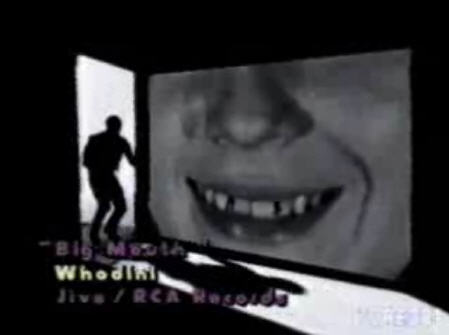
Whodini, "Big Mouth" [YouTube]. This is the long version with the spring reverb, etc. Note outdoor cube farm. The video is a barrel of fun and all the hilarity kind of disguises what a lean, mean song this is. When this version first appeared on '80s radio 'twas a unique thing in the audio landscape. Possibly the most minimal pop then extant.
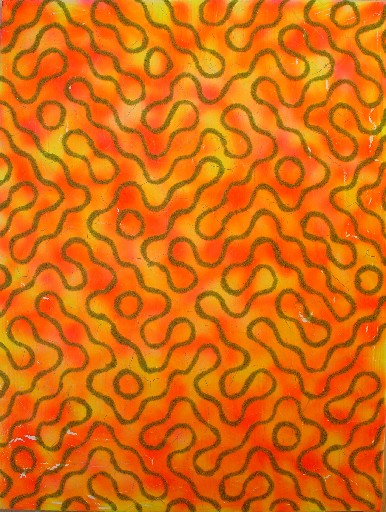
David Szafranski, Captain Freedom, mixed media on canvas. More from this series here.
Data Is Nature has a great essay on biological and mathematical parallels to Szafranski's paintings.
Carl Ostendarp wallpaper--based on a Dr. Seussoid painting of his from Google Images. Ostendarp once told me was interested in the work of painter Ralph Humphrey, and you can certainly see some connections. I'm not so wild about Humphrey's polychromatic, imagistic shaped canvases from the early '80s (especially the pebbly texture), but the more restrained work from the '60s and early '70s looks nice, from the website, at least. It occupies a territory somewhere between the Myron Stout/Leon Polk Smith school of abstraction and what would later be called "New Image" painting (Susan Rothenberg, Neil Jenney, et al). Ostendarp's wrinkle is adding more media-aware, boomer-centric cartoon iconography, such as these Dr. Seuss hands, to that milieu. His paintings are notable for their flatness and lack of inflection--the dry application of flashe paint on linen is antithetical to the buoyant, comedic imagery. Perhaps this contradiction is what led Marxist critic Joshua Decter to write the Artforum review that "destroyed Ostendarp's career" (at least that was the buzz circa 1995, when I first moved to New York). It may also just be that Decter had a lousy eye, a gift for tendentious review-writing, and too much damn power at the time.












If you are looking at this on Bloglines you will see vertical strips of white space between the columns. That is not intended; I know we can't control how browsers read html (or RSS) but I'm not too keen on automated blog readers that change images from the way they appear on their original pages. I'm happy if you're looking at this blog on Bloglines but want you to know that it's an inaccurate view of my page and recommend clicking through occasionally.
Recommended: Paddy Johnson's takedown of the New York Times' "Screens" blog, for the crimes of banality, bogus ironic distance, and, least pardonable of all, light posting. Blogging is a particular knack; not everyone has it and not everyone is driven to post every day. As Steve Gilliard has often pointed out, going to the "right" schools and meeting the "right" people was a prerequisite for success under the old media, gatekeeper model. Once you schmoozed or credentialed your way into one of those gigs, it was yours to command and audiences were yours to bore forever. With blogging anyone with talent can find an audience without going through the usual career abasement, but the downside, if it is one, is you're only as good as your last party. But whether the itch to blog waxes or wanes, it's supposed to be about your passion(s). It's not about rattling off a long list of current video formats and trends ("web video, viral video, user-driven video, custom interactive video, embedded video ads, web-based VOD, broadband television, diavlogs, vcasts, vlogs, video podcasts, mobisodes, webisodes, mashups and more"), as the "Screens" blogger does, and then apologizing for it by breezily calling it all "senseless" (as in, "we make sense of the senseless"). That just won't wash when people are hungry for information, amusement, and some kind of honest context.
A recording of my bookstore talk with Ed Halter last Wednesday, along with some photos, has been posted here. We discuss Halter's book From Sun Tzu to Xbox: War and Video Games (Thunder's Mouth Press/Avalon, 2006) and the author takes some questions from the audience. The .mp3 lasts about an hour and it's a good, clear recording, so I recommend it as a lively, information-packed introduction to some of the themes and ideas in the book.
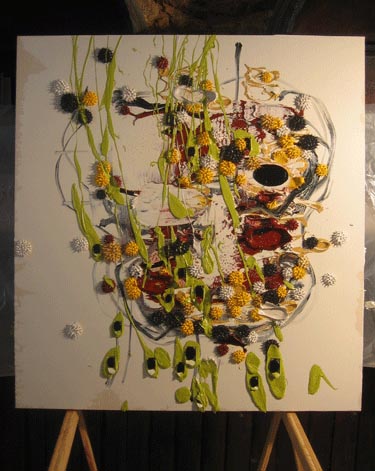
New Dennis Hollingsworth painting. It's a beaut. I like the suggestion of a head, the unfinished Ryman-esque quality of the edges, and the physics-flouting, flying-off-the-canvas dynamism of the paint. The sensuousness of that thick buttery substance communicates even in pixel form. Yum.
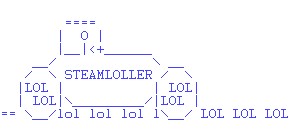
ascii artist unknown
"808 Straight" [mp3 removed]
Some dancefloor-type beats. A mix of hardware and software instruments, analog and digital, but entirely electronic: every sound originated as a voltage.
I haven't been following the Grime scene that closely, but after listening a bit to this site that bloggy recommended, I think I'm in the ballpark with what I'm doing here. I need a fuller bass sound, though, and more dubby beats (that's all). My main influences are still electro, acid house, and a kind of prog sensibility. I'm not that "street." I'd like to work on that.
This dubstep track "Midnight Request Line" by Skream is excellent.
Update: bumped the volume on "808 Straight" slightly.
Variety, July 20, 2020: Linklater to Give Scanner "Makeunder" Using Original Footage
"It hasn't held up over the years," admits the sexagenarian erstwhile slacker Richard Linklater, now one of Hollywood's leading directors, speaking of his 2006 film A Scanner Darkly. "I don't know why I let them talk me into using those damn filters for everything," he says. "That digital rotoscoping technique was momentarily cool in the early '00s, but let's face it, it made Winona Ryder look cretinous in some shots. Her features were sliding all over her face. Woody, too," he adds, referring to the late Woody Harrelson, who also played "Munson" in Kingpin.
Film fans agree. "The rotoscoping technique was just wrong for that material," says blogger Joe Chip, who had a brief cameo in the film. "Take the scene where Keanu Reeves addresses the Rotary Club," Chip says. "He's wearing a suit that digitally scrambles his features, masking his identity. It's a dramatic, surreal effect, but the problem is, with that rotoscoping technique, everyone in the room looks like they're wearing a scramble suit."
That scene and others are being re-edited to remove the digital effects except where they're needed to advance the plot--such as in the "hallucination sequences" where Reeves imagines his housemates as giant insects. Other film buffs are ecstatic about the proposed changes. "Robert Downey, Jr. did some of his best work in the picture," says director Arnold Kott. "It was a riff on his creep in Altman's Short Cuts, and you hated to see his talent buried under all that faux-artistic, Photoshop-like filtering."
But others don't think the changes will make any difference. "Linklater and Dick weren't the right fit," says Bruno Bluthgeld, a scholar of Philip K. Dick, whose book the movie was based on. "Scanner was an interesting mistake the way Cronenberg's Crash was. The novels were rooted in their eras, and just as the Swinging London sexual licentiousness of the J.G.Ballard book made no sense in the post-AIDS '90s, Scanner was a tale of the late '60s/early '70s, when a generation came down off a psychotropic high and got gobsmacked by harder stuff. This was an anachronism in 2006, when the drug blight du jour was meth labs in the sticks. And not that it should matter, but the rootless addiction hell Dick went through isn't comparable to Linklater's student experiences crashing on couches in Austin, TX."
We'll know soon enough: the newly scrubbed Scanner is due out in 2021.

"The ashy, veiny hand reaches out, gas pump nozzle in hand, a stream of 'S'es pouring forth from its spout like precious drops of gasoline. Together, the hand and pump give off an eerie glow as Honest Abe looks onward, his gaze obstructed by an exaggerated dot screen. George Washington is barely visible, shrouded by an orange shadow of depression. The message is clear: Rockland County joins gas sales tax capping."
From a great, mercilessly cruel, blog post from Ironic Sans on The Art of 1010 WINS. (via mo, mbs, et al) "The radio station 1010 WINS is for New York City what CNN Headline News is for cable television. Itís just nonstop headlines, weather, and traffic, repeating every 22 minutes. Their slogan is, 'You give us 22 minutes, and weíll give you the world.' Their website, 1010WINS.com, features local headlines and news stories mixed in with syndicated newswire stories. But for me, the real treat is the unintentional art gallery at 1010WINS.com. Sometimes, 1010 WINS uses photos from the newswire. But often, some Photoshop
1010 WINS also does unbearable audio montages, something I was complaining about on this blog on September 12, 2001.
Tonight at 8:00 at the Brooklyn bookstore BookCourt I'll be talking with Ed Halter about his book From Sun Tzu to Xbox: War and Video Games (Thunder's Mouth Press/Avalon, 2006), covering a range of topics rather pertinent to what has been called either World War III or World War IV, depending on whether you're listening to former House Speaker Newt Gingrich or former CIA director James Woolsey. These include, most centrally, America's Army, a realistic game developed by the military as both a recruiting and training tool, but also combat simulators flacked at high tech trade shows, behaviorist game designers concerned with "making memories" in players, Americans blowing away virtual Bin Ladens after 9/11, games such as "Under Ash" and "Under Siege" marketed to the "Arab Street," and American activist/left hacks of violent games. The announcement for the event is a here; earlier posts about the evening are here and here. I hope to see you there.
8:00 pm
BookCourt
163 Court Street
Brooklyn NY 11201
map and directions
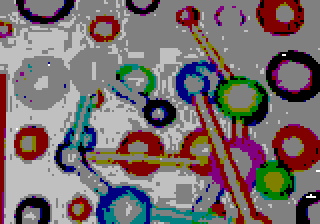
Highly recommended: video by Oliver Laric [Quicktime .mov] titled 787 Cliparts, via the Rhizome.org blog. It's 787 frames of generic cartoon line drawings (known as "clip art" from the days when people used scissors) blended together into a stop-motion animation. The flow is quite dazzling and lyrical. It recalls the Aeon Flux episode "Chronophasia," where Aeon becomes unstuck in time and transforms into hundreds of historical characters, rapidly changing costumes and hairstyles, as she walks across the room. And it's a vast improvement over the rather nauseating "scramble suit" in Richard Linklater's misbegotten A Scanner Darkly. (Prediction: 14 years from now Linklater will release a director's cut of that film restoring all the live action footage he shot, and do a big mea culpa for burying Robert Downey Jr. and all the great Philip K. Dick dialogue behind an obnoxious Photoshop filter. One cries for what that film could have been. Downey is a perfect Barris and the "sitting around the crash pad" scenes are as hilarious as they are in the book.)
Also recommended: Satellite Jockey's "Low Pressure (Sound) System Mix" [18 min / 20 mb .mp3], consisting of the geosat/bleepcentric pieces below. Gritty, sonically stimulating, often quite pretty:
1. Vladmir Ussachevsky - Wireless Fantasy
2. Kaffe Matthews - She could
3. Kid 606 - Site Specific Sound Installation
4. Alva Noto - 06-f117.tiff
5. Fennesz - Before I Leave
6. AGF - Loading
Better get it fast, SJ (aka Rick Silva) is notorious for removing great material from the web right after he posts it.
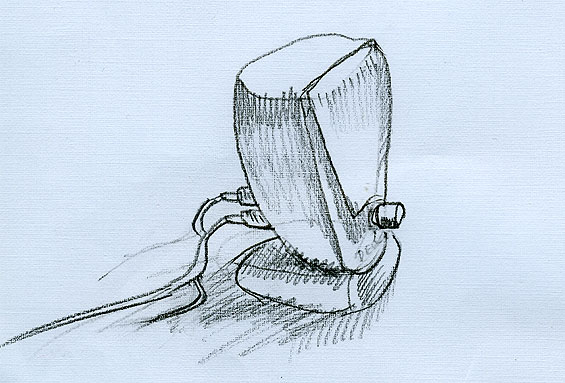
Ed Halter, whose book From Sun Tzu to Xbox: War and Video Games we'll be discussing at BookCourt in Brooklyn tomorrow night (y'all come!), referred me to this discussion at Henry Jenkins' blog about video game criticism and the topic of "why don't games have their Lester Bangs or Pauline Kael?" You could substitute "electronic/digital art and music" for games in that discussion and most of it would be relevant: that the critics will emerge in a generation from the ranks of kids consuming the products now, that criticism does exist but mostly on blogs and chatboards and not the established print publications, etc. Games have a different problem in their climb to mainstream acceptance, which is that, as one commenter pointed out, the experience varies so much from one consumer/player to another--and not just for the usual reasons of "the squishy subjectivity of art" but because the game has decision trees that could result in completely unlike experiences for the novice and the advanced player. In an earlier post I described the pleasures of watching my nephews playing Super Mario 64. They're experts so I got more out of being a spectator than I ever would have gotten as an inept player. The "game art" Halter describes in his book that I think I'd like best are the pieces that take apart the games and reassemble the fragments as "objects of contemplation," for example, Workspace Unlimited's Diplomatic Arena, which consists of world leaders and villains indiscriminately slaughtering each other to a montage soundtrack. Some earlier thoughts of mine on the "problem of interactivity" are here and here.
Bern, of the 8-Bit rockin' duo Bodenstandig 2000, on why he doesn't like the iPod:
We know that mp3 is part of our relative poverty, but Apple's proprietary digital rights management is an extremely stupid answer. I am the engineer-like type of guy (or at least an engineer-sympathizer) and I still canít get over these now-so-common crippling of technical possibilities. Appleís iPod? Yes, they look good and maybe they are the last bastion of classical brAun-like industrial design vs. chinese-turkish styling-trash for pimps and bitches, but still: They are crippled and I donít buy one.I agree with this. As a nascent mp3-making musician, I would rather get the product out there via "the chinese-turkish" free mp3 sites that link to me than use iTunes. At home I use Winamp to play music by others, because it doesn't stink of some kind of monopolistic capitalist scheme. Information wants to be free. (What a quaint idea!) The extent of my own capitalism is, send me 10 bucks and I'll send you a CD-R with as much music as I can put on it. For the money you get higher res recordings, the music all in one place, and no time-consuming downloading. You can rip the songs, whatever, just don't pass it off as your own work. My address is on my faq page. Check or money order to "Tom Moody."
1. You cannot just copy a song to an iPod and play it, youíll need iTunes.
2. If you buy a Bodenstandig-song at iTunes, you cannot play it on every mp3-player, you need an iPod.
"Aruba '85" [3.1 MB .mp3]
We're having sort of a heat wave here: nothing compared to Texas summers, but I'll go along with it. In honor, this piece has kind of a jazzy, tropical, Latinate feel. I wrote the melody fairly quickly a few days ago but felt it still needed something, so I busted my hump writing some harmony parts. I wish I could say I learned something about chord theory but I'm still doing everything mostly by ear. The challenge was to write additional notes and variations on the main theme without losing the original syncopated character of the verses. On the third iteration there's a kind of barrelhouse thing that's not very Latin, but it's interestingly quirky and lilting so I left it in. The "bass" is the characteristic Mutator twang bending some tuned drum notes--it stays constant through the piece, maybe too constant, but it's only 2 minutes. The rest is percussion from various sources.
Update: I guess I should mention that just because I said the piece "has kind of a jazzy, tropical, Latinate feel" doesn't mean it is jazzy, tropical, Latinate song. I think it's an "art piece" in that the repeating electronic bass line is static and trancelike in its textures and the jaunty electronic piano parts seem to be imparting forward momentum the piece doesn't have. Thus those iterative piano parts hang like fruit in jello to be individually considered for their simple but rather classically fabricated harmonic structures. The song is supposed to be problematic but also fun and pleasurable in a way I think a lot of 20th Century music wasn't.
Update 2: I took out the griping in the above update--that's a constant temptation with a blog. Thanks to Pierre for listening and documenting the process of recording this piece on his end--he is turning surfing into a Fluxus event with his series on listening to music.



































Hate to poop the party, but y'all really need to find someplace besides MySpace to blog and be creative. It's evil now.



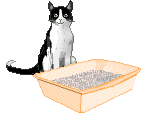





Next week, Wednesday, July 19, I'll be guest moderating a talk at the Brooklyn bookstore BookCourt; the featured speaker is Ed Halter, Village Voice critic and author of the just-published book From Sun Tzu to Xbox: War and Video Games (Thunder's Mouth Press/Avalon, 2006). The announcement for the event is a here, on the book's blog.
After exploring the intertwined histories of combat and play, from chess to modern "war game" exercises, Halter probes the nexus among the US military, academia, Hollywood, and the gaming industries that led to the development and promotion of such popular games as Full Spectrum Warrior and America's Army. I almost wrote "unholy nexus" but that's probably not the phrase Halter would use. He has a deceptively calm "just the facts ma'am" style that lays out all the information and leaves it to readers' heads to explode. As in, how sick is it that these "fun" games are both a recruiting tool aimed at the poor and impressionable and a trainer of hardened killers to be sent into the Iraq/Afghanistan meat grinder? How ridiculous is it that our tax money is paying for laboratories that explore "subtle effects of light" that heighten a game's realism? The book then ends with descriptions of projects by creative types with a bit more leftist, activist slant. I'm just starting the last chapter and taking notes as I go--doubtless I'll have additional placid thoughts up on the blog as next Wednesday approaches.
From Juan Cole, an update on the sectarian civil war in Iraq (thanks, George!). See also the PS at the bottom of the post: It's great to hear the feds "fired" Halliburton but it's not likely corruption will end any time soon--too many military procurers in the Executive and Legislative branches enjoying cocktail weenies with contractors. We're going to suffer when the real bill comes due.
At Muqdadiyah, a mixed Sunni-Shiite town north of Baghdad, guerrillas came to a bus station, separated out 24 or more Shiites from the other passengers, and took them to a nearby village where they killed most of them (al-Zaman says they murdered 22). The massacre is a continuation of the tit for tat "identity killings" that began last Sunday when Shiite militiamen massacred Sunnis in al-Jihad district of Baghdad. This tactic has brought the low-intensity civil war in Iraq to the boiling point.
[...]
In a rare outbreak of brutal candor, Prime Minister Nuri al-Maliki revealed on Wednesday that the daily violence in West Baghdad has not been random, but rather derives from a concerted plan by the Sunni Arab guerrilla movement to take over West Baghdad politically. He insisted that their advance in Karkh district had been repulsed, whereby they were attempting to move north.
My guess is that a key objective of the guerrillas is to surround and besiege the Kadhimiyah district of north-central Baghdad, which lies to the west across the river from Adhamiyah, a Sunni Arab stronghold. Kadhimiyah is the site of a very major Shiite shrine, that of Imam Musa al-Kazim,the seventh Imam or divinely-guided dynast of the House of the Prophet. The middle-class Shiites there are more or less behind enemy lines and isolated from the lower-class Shiites of East Baghdad (Sadr City). The guerrillas already have demonstrated that they can plunge Iraq into the fires of Hades by blowing up a shrine. I am sure that everyone in authority in Baghdad knows all this, but I don't have any confidence that Kadhimiyah is properly protected. It has been the site of many horrific bombings.
Eyewitnesses to the massacre at the al-Jihad District are now saying that the Shiite militamen who undertook the killings had with them long lists of ex-Baathists who had held office under the old regime but had been purged by the Debaathification Committee. The Debaathification Committee has been dominated by Ahmad Chalabi, and much of the documentation for its work was turned over to Chalabi by Donald Rumsfeld's Department of Defense. Prime Minister Nuri al-Maliki also played a central role in the Debaathification Committee. How have these lists leaked to local militias[?]
Al-Zaman/ DPA say that Sunni Arabs in the West Baghdad districts of Amiriyah, Khadra, Jihad, Ghazaliyah, Sayyidiyah and Al-Dura (Dora) have formed emergency neighborhood patrols for fear that Shiite militias from nearby Shiite-dominated districts to the east will make further raids into their areas. Muezzins or callers to prayer in the Sunni mosques of the Khadra district used amplifiers to call for volunteers, and dozens of young men responded by taking up arms. They especially hastened to do so after armed militiamen attacked the Muluki Mosque in al-Amiriyah District near Karkh late on Wednesday. They set up concrete blocks as barriers barring entry to the Khadra District. As soon as the callers to prayer broadcast the attack on the Muluki Mosque, shopkeepers and merchants in the commercial district closed their establishments.
This narrative of innocent Sunni Arabs policing their neighborhoods from predatory Shiite attacks on mosques obscures those other processes that PM al-Maliki described, whereby the Sunni Arab guerrilla movement is trying to take over these districts politically and extend its sway to Karkh. In a civil war, disentangling offense and defense is no easy task.
[...]
PS
About all those health centers supposedly built in Iraq with our $20 bn. in US tax money. Not so much.
"Mutator OD Bass (Long Version)" [4.8 MB .mp3]
I came back to this piece from a few months ago, adding some more arpeggios using a different Mutated (filtered) synth and a jaunty "surprise" theme at the end to lighten up the doom and gloom.
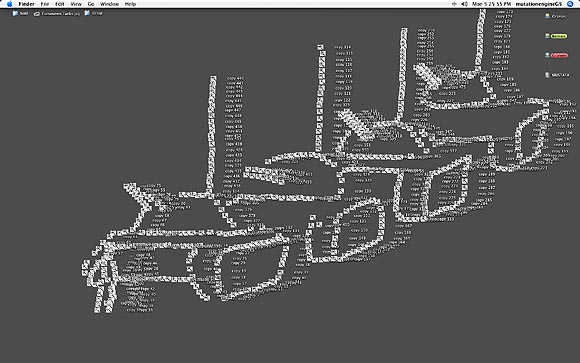
From Justin Strawhand's series Desktop Portraits. Screenshots of his desktop showing Tiananmen Square tanks made entirely of "shrink and enlarge" icons. (Other drawings include a self portrait, Popeye, and Bush Junior, made with other types of icons and desktop objects.) Sort of a new Internet-era cargo cult art. One thinks of the Afghan rugs depicting helicopters and Kalashnikov rifles.
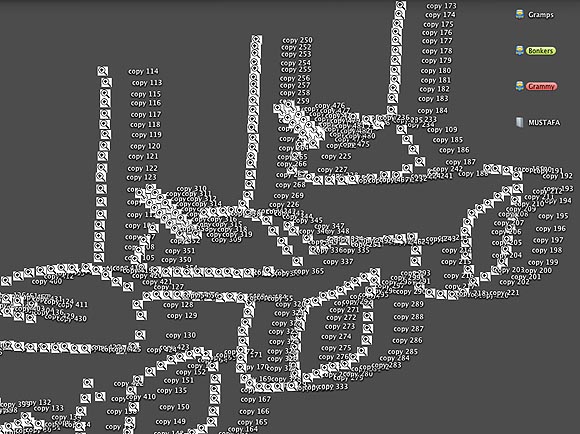
A different view of the infamous World Cup "head butt." (To paraphrase Alicia Silverstone, "I may not know my soccer but I know my LiveJournal.")
In the comments we've been discussing the issue of presenting Paper Rad artists as individuals as opposed to promoting them as a collective. Someone asked whether the decision to do the former originated with the gallery or the artists. My reply:
I don't think it matters so much how the decision got made. Every step in the art world ends up being so strategic and fraught with importance. When I said the power of the status quo is huge, well, I'm up against it, too. All our brains are colonized by these social Darwinian ideas of individuals struggling against individuals. I think here the issue is one of mystique-building. Everyone assumes the weight of commerce and habit will eventually turn the collective into a "bunch of talented, readily identifiable individuals" so it would be cool to hold out as long as possible resisting that "inevitability." A good role model would be the musical group The Residents, who perform in masks and reveal little of their back story--I still have no idea who those people are. Who sings? Who does the writing? Are the southern accents real? Are they really from Louisiana? Are they men? WASPs? I'm sure I could figure some of that out googling but they never really made me *want* to know. We should just be listening, not nosing after "stories." And they're in music where a certain amount of ego-submersion is expected. In art you would drive the whole art-historical trainspotter structure insane if you continued year after year to thwart the all-important Alfred Barr chart of which rugged individualistic genius influenced which. This would never happen but it's nice to dream.




"Teleclysm" [3.3 MB .mp3]
This piece starts with "One Minute Techno Song," with a new "techno" theme added. Then, it slows down and goes into the "K-hole," and ends with the "techno theme" recast as a kind of a reggae song.
Teleclysm is a googlewhack--which means probably no one's used it before. It could be a really bad TV show, like Alias--I get so sick of the close-ups on that show that I want to reach through the screen and push the characters into the middle distance so I can see what's really going on.
I prefer to think of teleclysm as a horrible teleportation mishap--like Captain Kirk being split into Evil Kirk and Weak Kirk, or even worse, when the explosion of the "link gate" in Cowboy Bebop turned the moon into a belt of meteorites that constantly rain down on Earth.
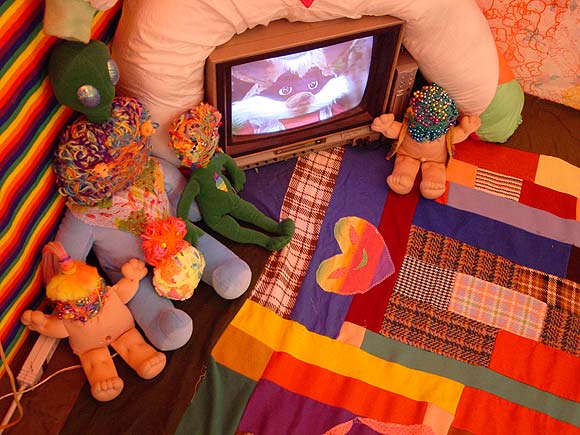
Another photo from the Jessica Ciocci show at Foxy Production. The orange cast is because this is taken inside a tent in the corner of the gallery--the lights are shining through various colored fabrics. I told Paper Radder Ben Jones that all the artists in the three-person collective are equally good, and I think they are, but this was my favorite of the Foxy shows, including their collaborative effort. It's the most materially sumptuous. I still don't agree with the gallery's decision to show the artists individually so soon, though. It's not like the Who, where you have Pete Townshend and John Entwistle solo albums or whatever. Or actually--you had a bunch of Who albums before the solo efforts started appearing. In any case, everyone knows and expects musicians to work as groups. The art world, however, still clings to the myth of the Leonardo-like solitary artist, moving culture forward in a single heroic leap. The most rad thing about Rad, to me, is their rejection of individuality cliches--who made what? Who cares? If you're a gallery you pound that message home. You don't immediately take your strongest artists and start presenting them the way everyone else presents their artists--as individual branded commodities. The power of the status quo is insanely huge. [/rant]
"One Minute Techno Song" [mp3 removed]
There might be more to this but I wanted to put it up while I have all the settings.
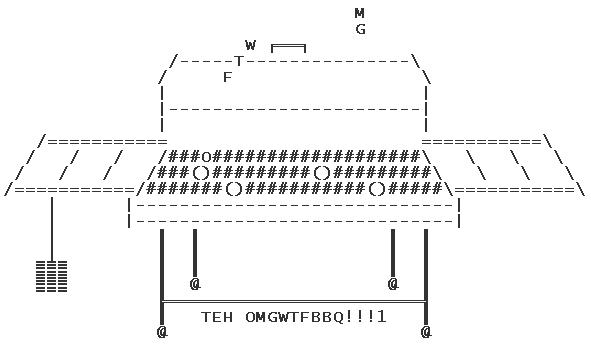



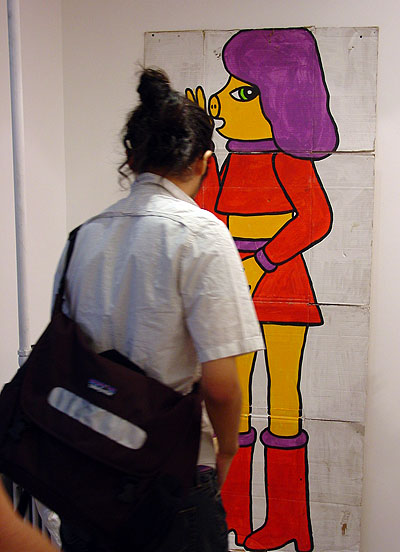
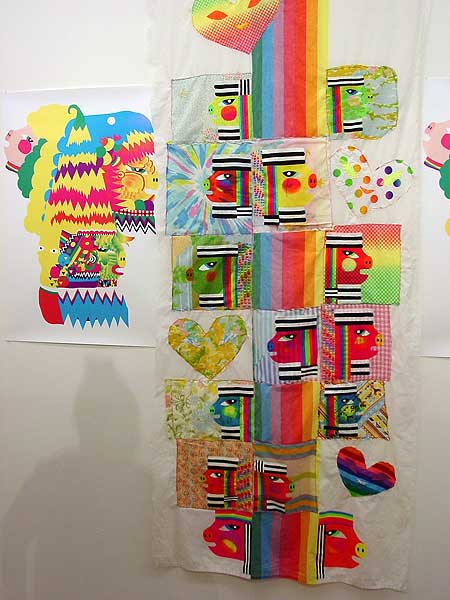
Photos taken at the opening tonight of Jessica Ciocci's exhibition at Foxy Production, in Chelsea. Jessica is a member of the collaborative art group Paper Rad. The show has a bright, inviting feel, and is full in the sense of meaty, not busy--a series of patchwork grids line the walls, each composed of a single predominant medium: paintings, snapshot photos, yarn, sewn fabric... The installation breathes, and makes you forget you are in a white cube environment; it could be a school art fair or swap meet but with underlying organization that belies the casualness. With her knack for arranging objects in physical space and command of materials, Ciocci does a great job of scaling up the underground comix sensibility to fit the room.

Drawings and animations by Ryuko Azuma here (blog front page here). [via] Not work safe if you live in a repressive Puritanical culture (i.e., most places). Fairly relentless psychosexual content: genitalia (human and alien), mutilation, b/d, but often exquisitely drawn. The style leans to anime/commercial illustration but twisted. I'm assuming from the blog photo that Azuma is female; a man drawing many of these images in the "West" would be looked askance upon by the pc left or locked up by the religious right. There is a lot of this type of work on the internet, meaning that it has always existed in sketchbooks that rarely saw the light of day until now. It taps the well of dark collective fears and yearnings that artists like Inka Essenhigh, Sue Williams, and Nicola Tyson also access, but I would argue they do it less effectively, especially now that they are market entities and can't "go too far." There is still a divide of what's appropriate in public and private and oddly the internet isn't considered the former, at least until someone decides to shut a site down.
"Pitch Sequences" [mp3 removed]
Sort of trancy, sort of Raymond Scott-y.
The main riffs are done with the Mutator filterbank--a run of notes written in my sequencer's MIDI pitchbend controller modulates a few basic drum machine hits into arpeggiated sounding melodies (which sound different in each channel).
On top of that is a sixteen note sequence which you can't hear--it is carved into four motifs using the "polyphony" mode of a four-voice analog synth. I didn't write these tunes so much as pick them from a range of choices the synth was randomly generating. Each sounds different because the four voices are each programmed differently. It was a bit of a pain in that I had to re-create the motifs by hitting "restart" many times when it got to the recording stage.
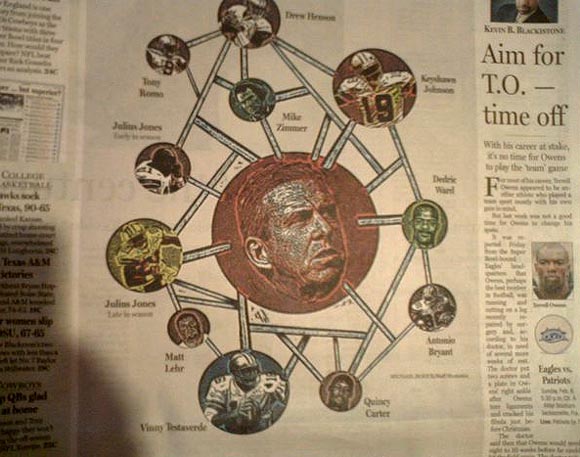
Photo by Jim Louis of an awesome newspaper graphic. I need to start reading the sports page.
"Heartbleet" [3.6 MB .mp3]
More analog adventures. I guess it's inevitable this music would go down the John Carpenter trail. He wouldn't do a beat like this, though; it's kind of Ringo Starr-ish. All sounds were made with a rhythm synthesizer and outboard filters--the tunable drums provide the musical notes. The "Ringo" beat is a cymbal LFO'd to give it a sharper attack and to make it pleasantly unpredictable (I hope).


"This really is a great country -- despite what George Bush is doing to destroy our constitution, our reputation and our freedoms." --AMERICABlog
"Sacred Machines Homage" [mp3 removed]
Straight up minimal techno. Not in the sense of "merely repetitive" but more in the spirit of trying to get the most for the least. The percussion doubles as a lead instrument.
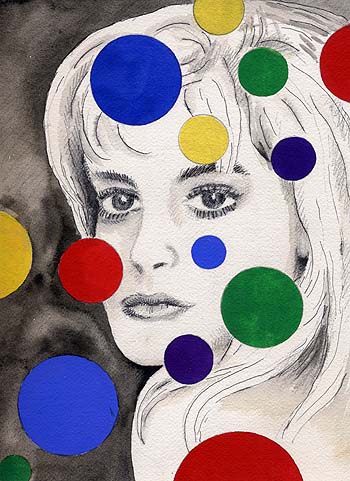
"Everyone Fights, No One Quits" [mp3 removed]
The beat is simple but has a strong forward drive--it's one of the first times I've actually liked the bitcrusher-type effect. The "main melody" is the Oki Computer 2, which I am finally starting to understand the guts of. It is a purely digital instrument that for its oscillator uses a up to 16 optional waveforms--as a cursor moves horizontally through them, each morphs into the sound of the one adjacent to it. Moving the slider rapidly back and forth results in interesting timbres. These are further shaped by a sequencer, envelope generators, and LFOs--all of which can also modulate the cursor position. Contrasting with the Oki in this piece are analog sounds that are heavily LFO'd and appear to wax and wane randomly.
"Rubber Elephants" [mp3 removed]
The tune started out as the Conlon Nancarrowish "Piano Three Hands," which I've been saying mainly sounds that way because of the pianos. Here I used a Moog-like synth playing the same notes as the earlier piece(s) (plus some new percussion). It's burbly and perenially slightly out of tune so I gave it a new title. It could also be Switched-On Inebriated Bach.

Image from the New York Times, during the run-up to the US invasion of Iraq.
The scenario was deeply ironic and cynical, yet average Americans took it on faith that war was necessary and being glorified. The glib news media didn't believe a word of the propaganda they dispensed, yet put the utmost creativity into fostering a sense of urgency. We could be talking about the Iraq war, but the subject is Starship Troopers, Paul Verhoeven's film of Robert Heinlein's not-so-crypto-fascist novel. It's hard not to watch it today without seeing it as a blueprint for how the New York Times, Washington Post, and the other major media sold Bush's war. Verhoeven cast attractive then-unknowns as the film's citizen soldiers and their intertwined stories completely grab you, even though the movie's oft-stated belief in force and violence as the ultimate arbiter of the greater good is dangerous malarkey. Similarly, the Times and Post played its part in stoking the masses, not just with Judith Miller's fabricated scare stories about Iraqi superweapons, but with the front page photos of soldiers hugging their loved ones as they prepared to depart for the habitat of the dangerous colonial Other. U.S. tanks and warplanes overran Iraq's borders, even though, as we all know, the country had nothing to do with the 9/11 attacks; Troopers briefly suggests, only to sneeringly dismiss it, that humans started the war by encroaching on the alien bugs' Galactic turf. Yet the Times and its ilk devoted little ink to root causes, in their bloodlust, misplaced desire for 9/11 revenge, and crass schemes to sell papers. Small surprise that Verhoeven saves one of the most gruesome deaths for an embedded reporter, whose last moments are filmed by a transfixed cameraman who doesn't put down his recording device to help.
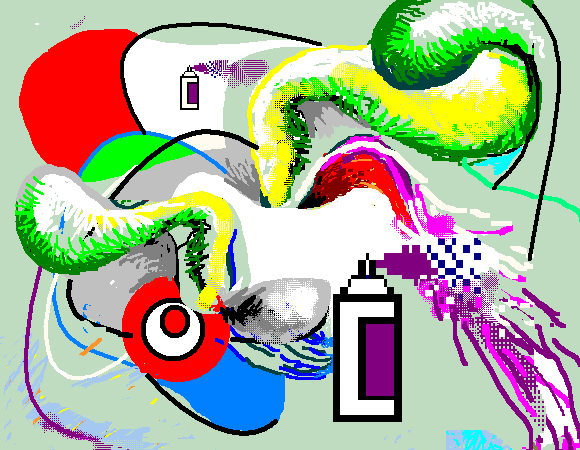
10 Songs for Analog Drum Machine & Sidstation
(These have all been posted before, just not as a group, except briefly over on the left. I just acquired an analog synth, which will probably get its own suite, then duets with the Sidstation, etc.)
"Two Bass Salad" [mp3 removed]
"Protest Song (Human Crab Louse)" [mp3 removed]
"Suite 6" [mp3 removed]
"Protest Song Variation" [mp3 removed]
"Crickets" [mp3 removed]
"Godhopper" [mp3 removed]
"Marching Morons" [mp3 removed]
"Clip City" [mp3 removed]
"Permanent Chase" [mp3 removed]
"Slow Hooterville" [mp3 removed]
Bonus tracks with the same instrumentation:
"artMoving" [mp3 removed]
"Suite 6 (Almost Live)" [mp3 removed].
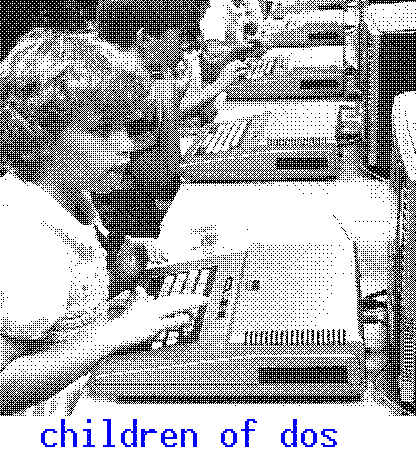
artist unknown - thanks to MBS for reminding me about that GIF scraper page for LiveJournal - there was so much good stuff I had to stop downloading so I could have a life -
